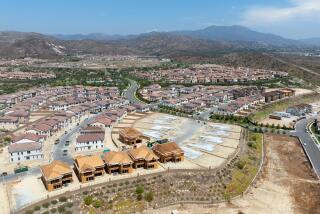Irvine Co. Official Says 60% of Company Land Is Useless for Building
- Share via
BLOOMFIELD HILLS, Mich. — More than 60% of the Irvine Co.’s extensive Orange County landholdings are unsuitable for buildings, company Vice Chairman Thomas H. Nielsen said Wednesday from the witness stand here as part of his testimony in a $500-million lawsuit filed by dissident shareholder Joan Irvine Smith.
Using maps and charts to depict varied development impediments on the company’s land, Nielsen also testified that development of more than 27,000 acres could be hampered by archeological concerns.
Nielsen took the stand as the company’s first witness in the second day of a trial to determine how much dissenting shareholders Smith and her mother will get for their company stock. The Irvine Co. contends that the 11% of the company owned by Smith and her mother, Athalie Clarke, is worth $88 million. Smith and Clarke, however, are demanding $500 million--$330 million for their stock, $5 million to cover legal costs and $165 million in interest that they figure has accrued since they first wanted to sell their shares in November, 1983.
Nielsen said the company determined in 1983 that 42,171 acres of its 68,078 remaining undeveloped acres--which represent nearly one-sixth of all land in the county--were unbuildable because of steep slopes, proximity to the El Toro Marine Air Station, proposed parks and other reasons. During a break in the proceedings, Nielsen said the company’s estimate has not changed in the ensuing four years.
While Smith’s attorneys were not scheduled to cross-examine Nielsen until today, they have already made it clear that they will contest the company’s definition of “unbuildable.”
In his opening remarks Tuesday, Smith’s lead attorney, Howard Friedman, said many areas of Southern California, including the exclusive Bel Air area of Los Angeles, have slopes greater than 30 degrees--the angle at which the company maintains it is economically unfeasible to build.
But Nielsen said Wednesday that construction problems in communities like Bel Air have led newer communities in Orange County to adopt more stringent slope restrictions.
Jabs at Presentation
During a break in the hearing, Friedman took jabs at the company’s presentation. “I never heard before of archeological spheres of influence,” Friedman said.
He was referring to 27,454 acres that the company says it is protecting for archeological purposes. Nielsen said that archeological considerations would not necessarily bar buildings on all of those acres, but would probably slow development.
Most of Wednesday’s hearing was devoted to the nuts-and-bolts of Orange County development, as Nielsen walked court referee Robert Webster through the maze of city, county and state agencies that all have a say in where, when and how the Irvine company builds its residential and commercial projects.
Since the trial is being held in Michigan--the state where the company is incorporated--Webster is expected to need extra briefing on the ins and outs of the Southern California real estate market. Last summer he visited Orange County, where he toured the company’s property.
Nielsen told the court Wednesday that in 1983, as today, one of the company’s major concerns was the funding and building of transportation corridors, interchanges and arterial highways. He said the company anticipated paying almost $300 million toward the estimated $800 million cost of building three additional freeways planned to serve the south county.
Refers to Corridor
Nielsen said the future of the company’s development plans depend most heavily upon the building of the Eastern Transportation Corridor, which would stretch from the Santa Ana Freeway to the Riverside Freeway. He said development of that corridor “lags very significantly in terms of political support.”
In Wednesday’s questioning, Nielsen also disclosed that the company--one of the pioneers of the “master planned community”--no longer has its own master plan for development.
Nielsen said when he became president of the company in 1983, he decided to adopt the general plans that the county and cities had crafted for the company’s property. “I felt it was important that we keep in mind the adopted general plans of individual jurisdictions,” he said.
More to Read
Inside the business of entertainment
The Wide Shot brings you news, analysis and insights on everything from streaming wars to production — and what it all means for the future.
You may occasionally receive promotional content from the Los Angeles Times.









